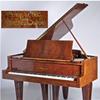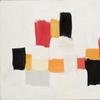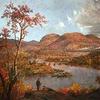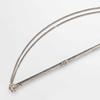“FIVE CENTURIES OF INDONESIAN TEXTILES – THE MARY HUNT KAHLENBERG COLLECTION” Wins First Place at 31st Annual WITTENBORN BOOK AWARDS at annual conference of the ART LIBRARIES SOCIETY OF NORTH AMERICA (ARLIS/NA)
- NEW YORK, New York
- /
- April 29, 2011
FIVE CENTURIES OF INDONESIAN TEXTILES: THE MARY HUNT KAHLENBERG COLLECTION (DelMonico Books - Prestel 2010) edited by Ruth Barnes and Mary Hunt Kahlenberg, was awarded First Place at the 31st Annual George Wittenborn Book Awards presented at the annual conference of the Art Libraries Society of North America (ARLIS/NA) in Minneapolis on March 25th.
Established in 1980 to honor the memory of premier New York City art book dealer and publisher George Wittenborn, the awards are given each year to North American art publications which represent the highest standards of excellence, documentation, and presentation.
Barbara Polowy, Chair, 2010 ARLIS/NA George Wittenborn Award, Head of the Hillyer Art Library Smith College Northampton, MA said, “The Wittenborn Committee is proud to bring Five Centuries of Indonesian Textiles to the attention of our members through the 2010 publication award. We were dazzled by your book. It clearly stood out in the array of worthy contenders and easily met the award criteria on all counts -- content, format, and scholarly apparatus.”
Much more than a wonderfully comprehensive and elegant new book by a group of experts sharing their cumulative knowledge and scholarship. FIVE CENTURIES OF INDONESIAN TEXTILES: THE MARY HUNT KAHLENBERG COLLECTION reveals the complexity and appeal of five centuries of ceremonial garments and sacred textiles from throughout Indonesia’s chain of tropical islands.
It has been lauded as ‘a visual tour de force’ of a very personal collection of over 350 Indonesian ceremonial garments and sacred textiles assembled over a thirty year period by Mary Hunt Kahlenberg, a world-renowned authority in the field of historic textiles. It was edited by Kahlenberg and Ruth Barnes, Senior Curator in the Department of Indo-Pacific Art at Yale University Art Gallery who has written extensively on Indonesian culture, textiles and related art forms.
Mary Hunt Kahlenberg says, “Producing a book can only be a labor of love, there is no other reason to put forth the energy required to make sure it is done right at every turn. Nor is it done single handedly, there are many people involved. In this case there were scholars from around the world, editors, designers, production supervisors and several who kept things in order and moving forward. The George Wittenborn award is given for the best art book based on scholarship, design and production. To have this acknowledgment is beyond my dreams.”
“The main reasons I decided to produce the book were, to introduce the world to these fascinating and visually compelling textiles by presenting recent scholarship and illustrating them with images that would give the reader an almost hands on impression. For centuries the women of Indonesia created textiles that were shaped by their social and spiritual practices. The strength of their beliefs is reflected in the beauty of their textiles, and for this, most importantly I want to honor them. To receive The George Wittenborn award will help to make that a reality.”
ARLIS/NA, founded in 1972, has nearly 1,100 members in the U.S., Canada, Mexico and overseas. It is the only professional organization in North America devoted exclusively to the concerns of the art information specialists.
Members of the 31st Annual George Wittenborn Memorial Book Award are: Barbara Polowy, Smith College, (chair); Rachel Beckwith, Hampshire College; Amanda Bowen, Harvard University; Laura Graveline, Dartmouth College; Linda Zieper, University of Massachusetts, Dartmouth.
ARLIS/NA selected two outstanding books published in 2010 to receive the 31st Annual George Wittenborn Memorial Book Award. - FIVE CENTURIES OF INDONESIAN TEXTILES: THE MARY HUNT KAHLENBERG COLLECTION (DelMonico Books - Prestel 2010) edited by Ruth Barnes and Mary Hunt Kahlenberg, was awarded First Place with Honorable Mention going to Pierre Puvis de Chavannes, Aimee Brown Price. New Haven: Yale University Press, 2010.
Previous winners of the George Wittenborn Memorial Book Award include: Marcel Duchamp. Étant donnés, Alfred Stieglitz: The Key Set: The Alfred Stieglitz Collection of Photographs; Eakins and the Photograph: Works by Thomas Eakins and His Circle in the Collection of the Pennsylvania Academy; The Paintings and Drawings of William Blake.
Textiles have been Mary Hunt Kahlenberg’s life work as well as her personal passion. After her textile design studies in Chicago, Vienna and Berlin, she served as curator at the Textile Museum in Washington D.C. This is where she encountered Indonesian textiles for the first time; subsequently as head of the Costume and Textile Department of the Los Angeles County Museum of Art she began the building of its Indonesian and Pre-Columbian collections. She organized LACMA’s “Textile Traditions of Indonesia” exhibition in 1977, the first major presentation of these textiles in the United States. Recently, LACMA hosted a continuation of Mary’s involvement with Indonesia, and LACMA with the 2008-09 exhibition, “Five Centuries of Indonesian Textiles: Selections from the Mary Hunt Kahlenberg Collection.”
Mary Hunt Kahlenberg also curated the Neutrogena and Lloyd Cotsen collection of Textiles and Folk Art now at The Museum of International Folk Art in Santa Fe and curated the opening exhibition and catalog of this collection “The Extraordinary in the Ordinary” for the Neutrogena Wing, which opened in 1998. She continues as an advisor to Mr. Cotsen’s unique “Textile Traces" Collection.
Mary Hunt Kahlenberg has written numerous books, including “Textile Traditions in Indonesia,” “Walk in Beauty: The Navajo and Their Blankets,” and has served as editor on several major textile and costume related publications. She is co-owner with her husband Rob Coffland of TAI Gallery-Textile Arts in Santa Fe, New Mexico.
Ruth Barnes is Senior Curator in the Department of Indo-Pacific Art at Yale University Art Gallery. She has written extensively on Indonesian culture, textiles and related art forms. Ruth Barnes grew up in Braunschweig, Germany. She studied German literature at Freiburg University, but gave that up to travel to Indonesia with her anthropologist husband Robert Barnes. Their first home was a small bamboo house in Kedang, on Lembata in eastern Indonesia, where they stayed for two years (1969-71). It was during these years that she decided to focus on textiles as a major indigenous art form, and to study their social significance and historical connections. Her most recent book relating to the region is Ostindonesien im 20. Jahrhundert: Auf den Spuren der Sammlung Ernst Vatter. It is an assessment of an early 20th century collection and an evocative account of revisiting the sites and people who contributed to it.
To Kahlenberg, It was much more than a “labor of love” for her when it came time to writing about and editing a book on her own collection of Indonesian Textiles. These textiles have consistently fascinated her. She says she felt an immediate and profound connection with the people, the villages, their stories, their history and most importantly their beauty. Her curiosity was sparked years before her first visit to Indonesia and grew as she traveled and studied more about what is still largely an unrecognized field of study.
“My sense of the depth of Indonesian culture, then and now, is that it would take many lifetimes to even begin to understand the riches there, and that my fascination would never end.”
While all private collections are individualistic by nature and reflective of a personal approach, Kahlenberg says her efforts cannot help but be colored by the fact that she is an art historian and spent years as a museum curator. “My collector side may not always be ruled by reason, but I am always mindful of bringing a sense of order to my decisions and not only allowing myself to be captivated by the beautiful qualities of the textiles. Helping to make Indonesian textiles better appreciated and understood is the purpose of presenting this book. I want to share what I have learned and communicate the mesmerizing appeal of these cloths.”
FIVE CENTURIES OF INDONESIAN TEXTILES – THE MARY HUNT KAHLENBERG COLLECTION is co-edited by Ruth Barnes and Mary Hunt Kahlenberg. In addition to the editors other scholars who have written essays for the book include: Traude Gavin, an independent researcher with a focus on the ritual textiles of the Iban groups in Borneo; Roy W. Hamilton, senior curator of the Asian and Pacific collections at the University of California, Los Angeles; Rens Heringa, independent scholar based in Leiden who spent many years living in Indonesia, where she researched batik and its meaning in Javanese society; Marie-Louise Nabholz-Kartaschoff who headed the Asian Textile Department at the Museum der Kulturen in Basel for 34 years curating many important exhibitions and Toos Van Dijk: a cultural anthropologist who published several books on social structures and rituals and wrote with Noco de Jonge, Forgotten Islands of Indonesia: The Art and Culture of Southeast Moluccas. It is the leading book in this area. Short essays on individual textiles were also written by, Linda Hanssen, Don M. Longuevan, Sandra Niessen, Garrett Solyom and Roxanne Watterson.
The book and essays reveal the experts’ extensive knowledge of Indonesia’s history, culture, geography and religious evolution. The book artfully describes both the incredible expanse of talent from the women who created these amazing woven and batik ceremonial garb and sacred cloths, as well as the underlying spiritual and cultural forces that motivated them.
The design was by Lorraine Wild of Green Dragon Office, Los Angeles. Lorraine Wild has received numerous awards from The American Center for Design and The American institute of Graphic Arts. “She has changed both the face and the voice of graphic design in the United States. Her accomplishments are unequivocal”. The production work was handled from beginning development stages though on-site production supervision by Amie Copper and Mikki Kalar of The Actualizers, New York. The photography was by Bruce White who has photographed art for catalogues of major museums throughout the country plus the White House Historical Association.
DelMonico Books – Prestel has published the book with 300 color illustrations in 408 pages in a hard cover slip case that creates a beautiful showcase for the wide range of textile innovations in Sumatra, Java, Bali, Sulawesi, Nusa Tenggara and Maluku.
“We are very fortunate to have received a generous grant that allowed us to create the kind of book that few art historians ever have the opportunity to offer for under $100. The book delves into the aesthetic experience, both tactile and visual, as well as its historic, anthropological and spiritual qualities. There is always more than one way to look at an object. For me, the pleasure of the information between the fingers is one of my great joys in studying textiles,” Kahlenberg says. “The other connection I feel is very important is knowing that this textile was made by someone and used by someone…..it communicates the sense of the individual and their life.
“Textiles are at the heart of a ‘community’ and, quite apart from any ceremonial purpose, the fact that these traditional weaving, batik and dyeing skills were passed down from one generation to the next says volumes about the society and culture in which they are found. A girl learns from her mother or close relative sitting on a porch or in a circle outside, close to home, and that just as the weaving progresses, so does her life. The Indonesian people recognize this and demonstrate a true reverence for their ancestors and the skills they passed down to them.
“Indonesian textiles are filled with ideas, formed from experiences that are imbedded in societal and spiritual phenomena. They have been reshaped by social and religious or magical practices that command reverence. The women of Indonesia had the responsibility to make these textiles, but they did not make them as works of art in the Western sense. Their motive was to entice good spirits to come closer and evil spirits to depart. The men largely worked in other mediums, including metal and wood.
“The process of dyeing was tied to seasonal and lunar cycles. Over a lifetime a weaver would develop precise ways of tying of the ikat threads, based on her relationship with spiritual guides. The skillful placement of the weft or the tying of the warp that forms a pattern reflects a weaver’s ability to imbue her weavings with the knowledge of her culture’s beliefs.
“Many people are familiar with the indigo blue associated with Indonesian textiles. In fact, the native color palette is mostly confined to a very limited palette of indigo, red, brown and white. The combinations carry specific meanings intended to evoke reverence, pride, awe, or pleasure. Textiles from island to island use the same palette in many different ways to make their local textiles distinctive.
“Having said that, it’s important to understand the anonymity of most of the Indonesian textiles I have collected, even though they might have been acquired from a family member. Namelessness is not new to this medium or to most modes of expression in the Western world prior to the Renaissance. In the West, religious thought and the glory of God inspired guilds to produce anonymous art. Because most Indonesian textiles are made for family or local use, it remains possible to identify the place of origin of the majority of textiles made within the past one hundred years by technique, format, colors, and motifs.
“As an art historian I was very happy to contribute scholarship resulting from research using radio-carbon dating that documented my contrarian belief that Indonesian textiles date back far longer in history than is generally acknowledged. While this broadened the ethnographical context, it also helps validate its art history context.”
Kahlenberg has received praise from early readers of the book who call it a “sumptuous, insightful and epic tour de force” which has reaffirmed her purpose -- to share her joy in discovering these amazing textiles with a broader audience. Not only do readers say it entertains and enlightens them, but it is being called the ‘best book on the subject.”
FIVE CENTURIES OF INDONESIAN TEXTILES focuses on the one genre of textiles that truly captivated Mary and captured her heart on her very first visit to Indonesia more than 30 years ago. Her passionate appreciation of Indonesian textiles has been at the core of a career that has been as impressive as it has been rewarding.
FIVE CENTURIES OF INDONESIAN TEXTILES
THE MARY HUNT KAHLENBERG COLLECTION
Edited by Ruth Barnes and Mary Hunt Kahlenberg
408 pages, 300 color illustrations Hardcover
in slip case 10 x 12.
ISBN: 978-3-7913-5071-4 $95.
October 2010 DelMonico Books – Prestel
















